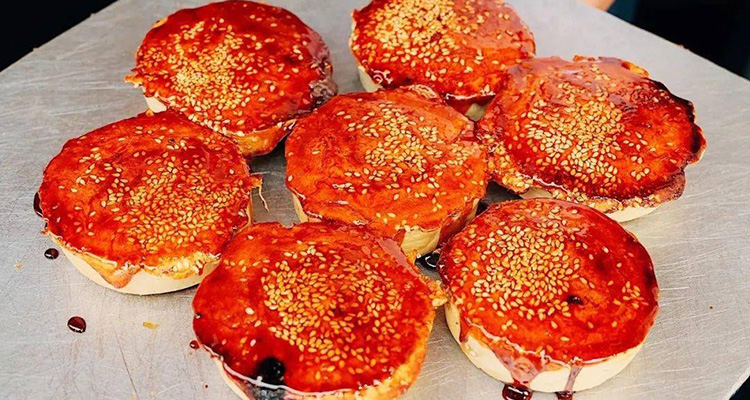Haitang Cake: Jiangnan Red Bean Pastry
In the misty charm of Jiangnan’s water towns, few treats can capture the essence of classical Chinese beauty like a freshly baked Begonia Cake. When its sweet aroma drifts from a small street stall, blending the fragrance of toasted flour with silky red bean paste, you realize — this is more than just a dessert. It’s an edible piece of art, a poetic taste of Jiangnan’s timeless grace. Follow this fragrant trail as we explore the history, craftsmanship, and irresistible flavor of Begonia Cake.
1. A Sweet Journey Through Time: Origin and History
The story of Begonia Cake dates back to the Qing Dynasty, when Jiangnan’s pastry masters, inspired by the elegance of blooming begonia flowers, created a dessert that mirrored their delicate shape and color. Crafted with precision using custom copper molds, these cakes became beloved across teahouses and banquet halls. Over 300 years later, Begonia Cake remains a symbol of refinement and a living reflection of Jiangnan’s graceful culinary artistry.
2. Jiangnan Aesthetics in Every Bite: Cultural Symbolism
In Chinese culture, the begonia flower—praised as the “Immortal of Flowers” and “Noble Concubine among Blossoms”—symbolizes beauty, prosperity, and elegance. Naturally, the Begonia Cake carries these same blessings. Once a staple at weddings and festive banquets, it embodies wishes for happiness and abundance. For today’s travelers in Suzhou or Shanghai, tasting a Begonia Cake means more than eating a pastry—it’s savoring a lifestyle of sophistication and tranquility. Whether you’re sitting in a Suzhou garden or strolling across Shanghai’s Nine-Curve Bridge, each warm bite connects you with Jiangnan’s poetic past.

3. Crafted with Heart: Ingredients and Artisan Techniques
Begonia Cake’s appeal lies in its simplicity and precision. The dough is made from refined flour mixed with malt syrup and water, while the filling is a smooth red bean paste, slowly simmered and lightly sweetened. A small cube of lard is added before baking—this key touch melts into the dough, creating a rich, flaky texture.
Traditional pastry chefs use begonia-shaped copper molds, brushing them lightly with oil before layering the dough and red bean paste. The cakes are baked over charcoal and turned frequently for even heating. When the cakes release a toasty aroma and a crisp “click” sounds as they’re unmolded, you’ll see perfectly shaped golden Begonia Cakes, their edges tinged with caramelized color—a feast for both the eyes and the taste buds.
4. A Symphony of Flavors: Texture and Taste
Freshly baked Begonia Cake is best enjoyed warm. The first bite reveals a crispy shell, followed by the soft, creamy sweetness of red bean filling. The subtle wheat fragrance of the crust and the smooth richness of lard create layers of flavor—sweet but never heavy. This perfect balance of crispness and tenderness is like a soft melody on your palate.
Locals enjoy it right at the stall, wrapped in thin paper, savoring it bite by bite while it’s still hot. It’s the essence of Jiangnan’s street food charm—simple, aromatic, and full of life. Pair it with a cup of Biluochun or Longjing green tea to offset the sweetness for an elegant afternoon tea experience.

5. Where to Taste: Local Foodie Map and Travel Tips
Best Spots to Try: Visit traditional food streets like Shantang Street or Pingjiang Road in Suzhou, and Shanghai Chenghuangmiao (City God Temple) or Qibao Old Street. These vendors often use time-honored methods passed down for generations.
Selection Tips: Look for stalls making Begonia Cakes on-site with a steady stream of customers. The ideal cake should be golden all over with slightly browned edges—proof of perfect heat control.
Eating Tips: Always eat it hot! Once cooled, the crisp texture fades and the cake becomes chewy.
Perfect Pairing: Pair with Chinese green tea like Dragon Well or Jasmine tea—the mild bitterness beautifully balances the cake’s sweetness.
Cultural Tip: Take a moment to watch the pastry masters at work—the rhythmic motions and aroma alone make it a living display of Jiangnan craftsmanship.
6. Bring the Taste of Jiangnan Home: Easy Homemade Recipe
Even outside Jiangnan, you can recreate this traditional treat in your kitchen. While it won’t perfectly match a master’s version, it captures the same sweet essence and homely warmth.
Simple Home Recipe for Begonia Cake
Ingredients: 150g all-purpose flour, 100ml water, 2g yeast, red bean paste, a bit of oil.
Steps:
- Dissolve yeast in warm water and knead with flour until smooth. Cover and let rise until doubled.
- Punch down the dough, divide into small portions, and roll into circles.
- Fill with red bean paste, seal like a bun, flatten slightly, and press petal patterns with the back of a knife.
- Heat a pan with a thin layer of oil and cook over low heat until both sides are golden and crisp.
Though lacking the copper mold’s ornate design, this homemade Begonia Cake is equally delightful—soft, fragrant, and full of satisfaction.
7. The Essence of Jiangnan on a Plate
Begonia Cake, a “flower” blooming on parchment paper, captures the spirit of spring, the charm of history, and the heart of Jiangnan’s artisans. It’s understated yet unforgettable. When planning your next trip to Jiangnan, make sure to include this edible heritage on your itinerary. Wander down a stone-paved old street, follow the warm aroma of caramel and flour, and treat yourself to a fresh Begonia Cake—the most authentic, heartwarming taste of southern China.


